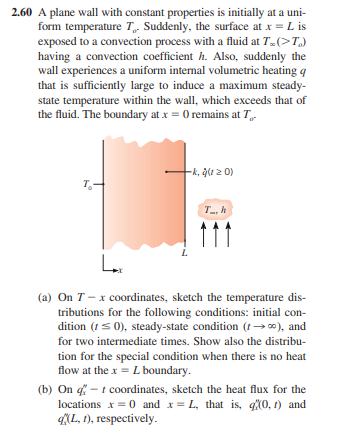2.60 A plane wall with constant properties is initially at a uni- form temperature T, Suddenly, the surface at x = L is exposed to a convection process with a fluid at T_(>T.) having a convection coefficient h. Also, suddenly the wall experiences a uniform internal volumetric heating q that is sufficiently large to induce a maximum steady- state temperature within the wall, which exceeds that of the fluid. The boundary at x = 0 remains at T T- -k, ģ(120) T_.h (a) On T-x coordinates, sketch the temperature dis- tributions for the following conditions: initial con- dition (t ≤ 0), steady-state condition (→∞), and for two intermediate times. Show also the distribu- tion for the special condition when there is no heat flow at the x = L boundary. (b) On - 1 coordinates, sketch the heat flux for the locations x = 0 and x = L, that is, qX(0, 1) and q(L, 1), respectively.
2.60 A plane wall with constant properties is initially at a uni- form temperature T, Suddenly, the surface at x = L is exposed to a convection process with a fluid at T_(>T.) having a convection coefficient h. Also, suddenly the wall experiences a uniform internal volumetric heating q that is sufficiently large to induce a maximum steady- state temperature within the wall, which exceeds that of the fluid. The boundary at x = 0 remains at T T- -k, ģ(120) T_.h (a) On T-x coordinates, sketch the temperature dis- tributions for the following conditions: initial con- dition (t ≤ 0), steady-state condition (→∞), and for two intermediate times. Show also the distribu- tion for the special condition when there is no heat flow at the x = L boundary. (b) On - 1 coordinates, sketch the heat flux for the locations x = 0 and x = L, that is, qX(0, 1) and q(L, 1), respectively.
Chapter2: The Kinetic Theory Of Gases
Section: Chapter Questions
Problem 81AP: One process for decaffeinating coffee uses carbon dioxide ( M=44.0 g/mol) at a molar density of...
Related questions
Question
100%

Transcribed Image Text:2.60 A plane wall with constant properties is initially at a uni-
form temperature T, Suddenly, the surface at x = L is
exposed to a convection process with a fluid at T.(>T.)
having a convection coefficient h. Also, suddenly the
wall experiences a uniform internal volumetric heating q
that is sufficiently large to induce a maximum steady-
state temperature within the wall, which exceeds that of
the fluid. The boundary at x = 0 remains at T
T₂
-k, ģ(120)
Th
Lx
(a) On T-x coordinates, sketch the temperature dis-
tributions for the following conditions: initial con-
dition (t ≤0), steady-state condition (→∞), and
for two intermediate times. Show also the distribu-
tion for the special condition when there is no heat
flow at the x = L boundary.
(b) On q-t coordinates, sketch the heat flux for the
locations x = 0 and x=L, that is, (0, 1) and
q(L, 1), respectively.
Expert Solution
This question has been solved!
Explore an expertly crafted, step-by-step solution for a thorough understanding of key concepts.
This is a popular solution!
Trending now
This is a popular solution!
Step by step
Solved in 2 steps with 3 images

Knowledge Booster
Learn more about
Need a deep-dive on the concept behind this application? Look no further. Learn more about this topic, physics and related others by exploring similar questions and additional content below.Recommended textbooks for you

